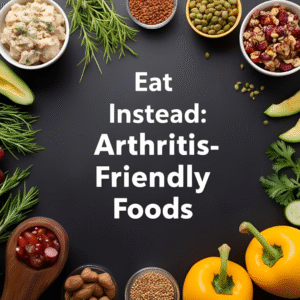Foods Bad for Arthritis
Foods Bad for Arthritis: What to Avoid to Ease the Ache
Foods Bad for Arthritis isn’t just “getting old.” It’s a daily struggle for millions—young and old alike—who face stiff joints, swelling, and relentless pain. Whether it’s rheumatoid arthritis, osteoarthritis, gout, or psoriatic arthritis, one thing is clear: what you put on your plate can either ease the pain or make it worse.
If you’ve ever felt like your joints were shouting at you after a big meal, you’re not imagining things. Some foods trigger inflammation, increase uric acid, or simply load your body with substances that aggravate your condition.
In this guide, we’ll explore the top 10 foods that are bad for arthritis, why they’re problematic, and most importantly—what to eat instead. Let’s dive into the kitchen and empower your joints with knowledge (and some tasty alternatives).
🔥 Understanding Arthritis and Inflammation
Arthritis is essentially inflammation of the joints. Inflammation can be triggered by injury or disease, but in chronic conditions like rheumatoid or osteoarthritis, the inflammation doesn’t shut off. This results in pain, stiffness, swelling, and reduced mobility.
Certain foods fuel inflammation, while others fight it. Knowing which is which can help reduce flare-ups and improve your quality of life.
🚫 The Worst Foods for Arthritis (and Why to Avoid Them)
1. Sugar and Refined Carbs
We all know the sweet stuff isn’t great for us, but when you have arthritis, sugar can be downright toxic.
Why it’s bad: Sugar triggers the release of inflammatory messengers called cytokines. It also contributes to weight gain, which adds stress to joints—especially in the knees, hips, and lower back.
Common culprits:
- Soda and sweet tea
- Candy and baked goods
- Sugary breakfast cereals
- Packaged snacks with high fructose corn syrup
Smart swap: Satisfy your sweet tooth with antioxidant-rich fruits like berries or a small piece of dark chocolate (70% or higher).
2. Fried and Fast Foods
Tempting when you’re short on time, but these foods are a recipe for inflammation.
Why they’re bad: Fried foods are high in trans fats, advanced glycation end products (AGEs), and omega-6 fatty acids, all of which promote inflammation.
Common culprits:
- French fries
- Fried chicken
- Mozzarella sticks
- Drive-thru burgers
Smart swap: Try oven-roasted veggies or air-fried versions with olive oil. For protein, grilled salmon or lean chicken is anti-inflammatory and filling.
3. Refined Grains
You may think bread and pasta are harmless, but the highly processed versions can spike blood sugar and fan the flames of inflammation.
Why they’re bad: White bread, white rice, and regular pasta are stripped of nutrients and fiber. They act like sugar in the body, leading to insulin spikes and more inflammation.
Common culprits:
- White toast
- Regular pasta
- Pizza dough
- Pastries
Smart swap: Opt for whole grains like quinoa, brown rice, or whole wheat. They contain fiber, which helps reduce C-reactive protein (CRP)—a marker of inflammation.
4. Red and Processed Meats
Steak night might be satisfying, but it could leave your joints aching the next day.
Why they’re bad: Red and processed meats contain high levels of saturated fat, AGEs, and nitrates—all of which can trigger inflammation. For those with gout, they can also raise uric acid levels.
Common culprits:
- Beef burgers
- Sausages
- Bacon
- Deli meats
Smart swap: Go for plant-based proteins like lentils, beans, tofu, or omega-3-rich fish like salmon and sardines.
5. Dairy Products (for Some People)
Dairy is a controversial one. While some people tolerate it well, others with arthritis find it triggers flare-ups.
Why it’s bad: Some dairy proteins can irritate the tissues around joints in sensitive individuals. Full-fat dairy also contains saturated fats that may worsen inflammation.
Common culprits:
- Whole milk
- Ice cream
- Full-fat cheese
- Creamy sauces
Smart swap: Try unsweetened almond or oat milk, low-fat dairy (if tolerated), or dairy-free yogurts made from coconut or soy.
6. Alcohol
That glass of wine might help you relax—but too much can aggravate arthritis, especially gout.
Why it’s bad: Alcohol increases uric acid production, which can crystallize in joints and cause painful gout flare-ups. It also impairs liver function, making it harder to remove toxins that contribute to inflammation.
Common culprits:
- Beer (especially high in purines)
- Cocktails with sugary mixers
- Daily or excessive alcohol intake
Smart swap: Drink plenty of water or herbal teas. If you drink alcohol, limit intake and choose wine over beer when possible.
7. Salt and High-Sodium Foods
Your body needs a little sodium—but most of us are getting way too much.
Why it’s bad: High sodium levels can lead to water retention and increase blood pressure. Some studies suggest excess salt may worsen autoimmune responses and increase inflammation in people with rheumatoid arthritis.
Common culprits:
- Canned soups
- Frozen dinners
- Fast food
- Chips and pretzels
Smart swap: Use herbs, garlic, and lemon for flavor instead of salt. Look for “low-sodium” or “no salt added” labels.
8. Corn Oil and Omega-6 Fats
Omega-6 fatty acids are essential—but too much of them (without balancing omega-3s) can create an inflammatory environment in the body.
Why they’re bad: Diets high in omega-6s and low in omega-3s can aggravate joint pain and swelling.
Common culprits:
- Corn oil
- Soybean oil
- Margarine
- Some salad dressings
Smart swap: Choose olive oil, flaxseed oil, or avocado oil for a more balanced fat profile.
9. Artificial Additives
Many packaged foods are full of chemicals your body doesn’t recognize—and that can mean trouble for your immune system.
Why they’re bad: Additives like MSG, aspartame, and preservatives can trigger inflammation and immune responses in some individuals with arthritis.
Common culprits:
- Diet sodas (aspartame)
- Flavored chips
- Processed meats
- Frozen meals
Smart swap: Stick to whole foods with ingredients you recognize and can pronounce. Think fresh fruits, veggies, and simple homemade meals.
10. Gluten (for Some)
If you have celiac disease or are sensitive to gluten, it can cause joint inflammation and pain.
Why it’s bad: Gluten can provoke an immune response in sensitive individuals, leading to increased inflammation, especially in those with autoimmune forms of arthritis like RA.
Common culprits:
- Bread
- Pasta
- Cakes
- Crackers
Smart swap: Choose gluten-free grains like brown rice, quinoa, and certified gluten-free oats.
🥦 What to Eat Instead: Arthritis-Friendly Foods
Now that we’ve talked about what to avoid, let’s focus on what you can enjoy—because eating for arthritis relief doesn’t mean boring or bland!
✔️ Top Anti-Inflammatory Foods for Arthritis Relief
- Fatty fish (salmon, mackerel, sardines)
- Berries (blueberries, raspberries, strawberries)
- Leafy greens (spinach, kale, arugula)
- Nuts (walnuts, almonds)
- Olive oil (cold-pressed, extra virgin)
- Garlic and turmeric (natural anti-inflammatory properties)
- Whole grains (quinoa, brown rice, oats)
- Legumes (lentils, black beans)
🧘 Lifestyle Tips for Managing Arthritis Through Diet
Diet alone isn’t a cure—but combined with healthy habits, it can make a big difference:
- Stay active: Low-impact exercises like walking or swimming can reduce stiffness.
- Maintain a healthy weight: Less weight = less pressure on joints.
- Stay hydrated: Water helps flush out toxins.
- Keep a food journal: Identify your personal food triggers and avoid them.
❤️ Final Thoughts:
Living with arthritis isn’t easy—but small, consistent changes can lead to big relief. The foods we choose can either fuel the fire of inflammation or help extinguish it.
Instead of focusing on restriction, think of it as a way to nourish your body in a way that supports healing. With a little planning and creativity, you can enjoy meals that are satisfying, flavorful, and joint-friendly.
So the next time you’re tempted by greasy fries or a sugary snack, ask yourself: Will this feed my joints—or fight them?
Your body—and your future self—will thank you.



qx1q8f
d7tygk
I love how platforms like tyy.AI Tools simplify finding the right AI solutions-especially tools like the AI Instagram Assistant for streamlining social content creation!
It’s so important to remember gaming should be fun, not a source of stress. Seeing platforms like 888phl online casino embrace tech for smoother, faster experiences is great – less frustration can help! Let’s all play responsibly and stay aware. 😊
Interesting read! The psychology of engagement in these platforms-like the layered security & diverse games at 789pet slot download-really taps into reward systems. It’s fascinating how verification processes build trust, too!
bqlww2
Interesting points! High-stakes gaming really needs solid security, something jljl glory club seems to prioritize – good to see that focus, especially with apps & mobile access growing so fast. Definitely a platform to watch!
Interesting analysis! Seeing platforms like jilibay legit prioritize quick registration & localized payment options (GCash, PayMaya) is smart for the PH market. Accessibility is key for growth! 🧐
That’s a solid point about responsible gaming – crucial for enjoying any platform! I noticed legend link maya is a convenient deposit option, making it easier to jump into the fun and explore their game library. 👍
It’s great to see platforms prioritizing a smooth, secure experience – registration steps like those at arionplay app casino build trust. Responsible gaming starts with a solid foundation! Enjoy, but always play within your limits. ✨
It’s great seeing platforms like this prioritize responsible gaming & clear regulations! Secure account creation & verification (like with legend link maya vip) builds trust. A curated, compliant experience is key for Filipino players. 👍